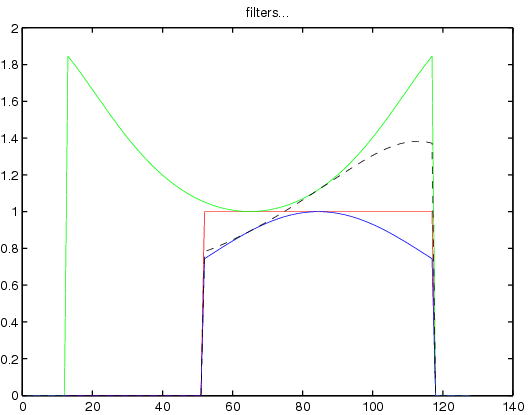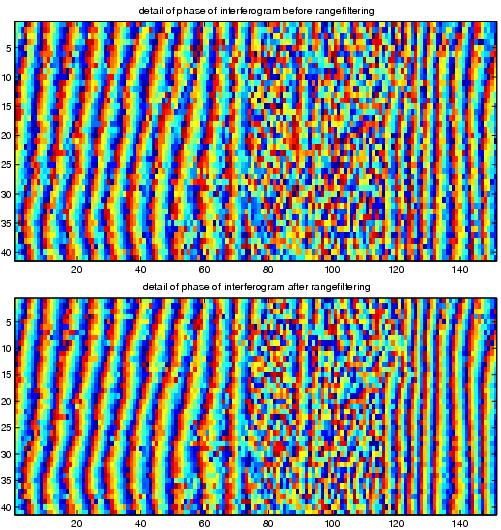



Next: Hamming filter
Up: Implementation
Previous: Method: porbits
Contents
After the resampling of the slave on the master grid is performed this
algorithm can be used. The local fringe frequency is estimated using
peak analysis of the power of the spectrum of the complex
interferogram. The resampling is required since the local fringe
frequency is estimated from the interferogram. This fringe frequency
is directly related to the spectral shift in range direction. (Note
this shift is not a shift, but different frequencies are mapped on
places with this shift...)
The algorithm generally works as follows.
- Take part of master and slave (e.g., 500 lines by 128 range
pixels.)
- Oversample master and slave and generate complex interferogram.
- Take FFT over range for all lines of complex interferogram.
- Take power. If requested, weight this powerspectrum with
auto-convolution of 2 rect functions with appropriate bandwidth.
(Actually, perhaps the spectrum should also be weighted with
autoconvolution of Hamming, but since I am not sure that this has a
big impact on real data this is not done.)
- Take moving average over the lines of the power FFT's for noise
suppression (kind of periodogram). (This was better implemented as
a convolution with a block function (e.g., 9 x 128)?)
- Estimate peak per line in oversampled/averaged powerspectrum of
complex interferogram. Estimate
 .
.
- This peak is directly related to overlap of spectra for this
part of this line. (See also Fig. 22.2.)
 .
.
- If SNR is above threshold (input of user, e.g., 3), remove
appropriate parts of spectra of master/slave. Optionally compute
inverse hamming window and new hamming window, and rect window to
filter one side of master spectrum, and other side of slave
spectrum. (See also Fig. 22.3.) Note that the
filter is mirrored (matlab fliplr) for master/slave. The SNR of the
peak of a random spectrum (sea) probably is a little larger than 1,
so threshold of 3 may not be large enough.
- Do inverse FFT for filtered master, slave, which yields the
filtered image in the space domain.
- Take next part of master and slave (e.g., 500 lines by next 128
range pixels) until all lines are filtered.
In practice this is done in blocks. These blocks are overlapping in
lines (because the averaging over lines means one cannot filter all
lines in the block), and not in range. Parameters that can be
adjusted are the FFTlength, the moving average mean,
the SNR threshold.
The fftlength should be large enough to yield a good estimate of the
local fringe frequency, and small enough to contain a constant slope
of the terrain. The total number of fringes in range directorion can
be easily estimated using the perpendicular baseline.
It is probably a good idea to add a card so an overlap in range
between blocks can be used. This avoids 'edge' effects, and increases
the filtering of terrain near, e.g., a lake (since the SNR for peak
detection will be higher for a number of blocks towards the noise).
This is not implemented yet.
See also [5], [7], [3].
See also our matlab toolbox.
Figure 22.2:
Peak estimation in spectral domain of (oversampled) complex
interferogram. Non FFTshifted.
 |
Figure 22.3:
Spectral filtering windows (inverse hamming, boxcar
(rect), and new hamming. Note these are FFTshifted.
 |
Figure 22.4:
Detail of interferogram with and without rangefiltering.
(fftlength=128, nlmean=15, snrtreshold=5). The perpendicular
baseline is about 200 m for this interferogram. The fringes are
clearly sharper after the filtering. The number of residues for
the interferogram was reduced by 20%. Subtraction of both
interferograms yielded a random phase, so no structural effect of
range filter implemenation is suspected.
 |




Next: Hamming filter
Up: Implementation
Previous: Method: porbits
Contents
Leijen
2009-04-14


